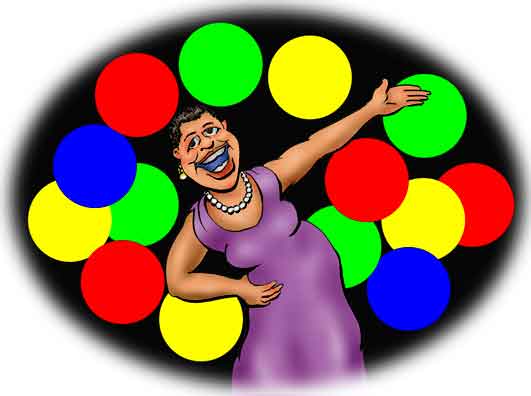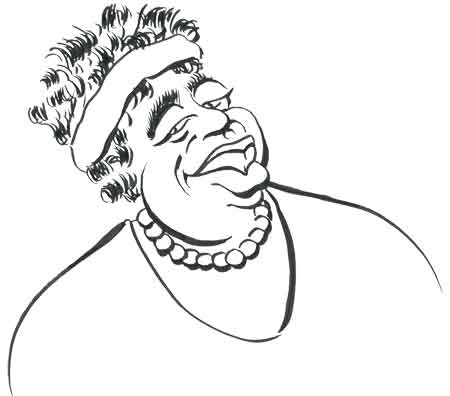Bessie Smith

(Click to Zoom In and Out)
As a kid Bessie Smith (she was born in 1894) found she had a talent for singing and at about eight began singing on the street corners in Chattanooga, Tennesse. She lived with her older sister and brother (her parents had died when she was young) and at age 18, she joined a traveling troupe of performers. This was, after all, the era where good music had to be live music and such traveling musicians - together with actors and comedians - were still common. At $10 a week the pay wasn't much, but it was enough to get by on.

Louie
He performed with Bessie.
Leading the troop was Gertrude "Ma" Rainey, a performer herself. But she was also a shrewd businesswoman and not only helped Bessie in the Art of the Blues but also taught her the economic side of the business. Ma herself was one of the earliest blues singers to make commercial recordings, and you can easily find her songs, including those with the up and coming trumpet player Louis Armstrong.

... and with Ma Rainey.
Bessie was touring under the auspices of the Theatre Owners Booking Association (also called T. O. B. A.), a major black vaudeville circuit. But she also performed regularly at clubs in the cities. She quickly moved from being a regional celebrity in the South to playing at major venues on the East Coast. In the early 1920's she settled in Philadelphia.
This was also the time where record companies were literally scrambling to find new talent. Naturally one of their scouts tapped Bessie and in 1923 she started recording for Columbia - a major label.
Bessie's first record, "Downhearted Blues", sold nearly 800,000 copies in six months. Everyone was flabbergasted. Naturally Columbia wanted more recordings and they called in a young pianist named Fletcher Henderson to be her accompanist. Bessie then began a series of tours where where she played to sold out audiences, some of which were largely white.
All in all Bessie recorded nearly 200 songs for Columbia, either solo or as part of a group. But by the mid-1930's the blues were falling out of popularity with the mainstream audiences. Columbia discontinued Bessie's contract, but in 1933 she was able to sign on with Okeh Records, then specializing in what were then called "hillbilly" and "race" records. But it was clear the tin-pan alley songs and the music of the big bands of Glenn Miller, the Dorseys, and Benny Goodman were the big money makers. Bessie only recorded four songs for Okeh before returning to her home in the South where she continued to tour.
However, Bessie still had her fans even in the big companies. In 1937, John Hammond, the now legendary record producer who was involved with almost every big name popular recording artist from the 1930's through the 1970's had arranged for Bessie to cut some more sides for Columbia.
Then on September 26 Bessie and her boyfriend Richard Morgan were driving from Memphis, Tennessee, to Clarksdale, Mississippi. Then at about 15 miles from Clarksdale the car struck a truck parked at the side of the road. The car flipped over and the truck driver simply drove off. Dick was uninjured.
But Bessie had been sitting with her arm out the window - this was the day before air conditioning - and she was severely injured with her arm receiving major trauma including multiple fractures.
Dick managed to stop a car with two men, one of whom was a physician, Dr. Hugh Smith. Dr. Smith immediately saw that not only was Bessie's arm fractured, but she had sustained severe injuries along her whole right side.
Suddenly yet another car came down the road and hit Dr. Smith's car. No one was injured but the couple in the other car became hysterical. By then two ambulances had been summoned and one took Bessie to the G. T. Thomas Afro-American Hospital which in the segregated South (and as the name suggests) only accepted black patients1.
Footnote
A commonly repeated story is that because the black hospital was some distance off, Bessie could have been driven to a near-by white hospital, and had she received more prompt treatment, Bessie may have survived. Another story was that she was first taken to the white hospital and refused treatment. Yet another writer said Bessie was taken to three hospitals and refused treatment.
Still another writer checked out the story and found the two hospitals were really about half a mile apart and that the time required to drive to either was about the same. The ambulance driver then most likely took Bessie directly to the hospital reserved for black patients.
That the commonly held story is not true should not distract from the fact that if Bessie had been taken to a white hospital she would have indeed been refused treatment. Decades after Bessie's death the head of - quote - "social services" - unquote - in a Quaint County in the American Southwest was adamantly opposed to admitting a black infant to a local hospital because no black person had ever been a patient there.
At the hospital Bessie's arm was amputated, but the main problem was her internal injuries which in those pre-antibiotic days and with relatively limited treatment options were often fatal. Bessie did indeed die later that day.
The hospital closed in 1940 and was renovated to a hotel. It's still open and the room where they owners believe Bessie died is not rented out and has memorial decorations to her memory.
References
Queen of the Blues: The Life and Times of Bessie Smith, Jennifer Warner, BookCaps Study Guides, 2014.
"Bessie Smith", Red Hot Jazz.
"Bessie Smith", Rock and Roll Hall of Fame.
"Bessie Smith (Vocalist)", Discography of American Historical Recordings.
"The Death of Bessie Smith", All About Blues Music."Death of Bessie Smith", Mississippi Encyclopedia.
Mother of the Blues: A Study of Ma Rainey, Sandra Lieb, University of Massachusetts Press, 1981.